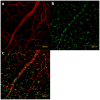An ocular view of the IGF-IGFBP system
- PMID: 23578754
- PMCID: PMC3833084
- DOI: 10.1016/j.ghir.2013.03.001
An ocular view of the IGF-IGFBP system
Abstract
IGFs and their binding proteins have been shown to exhibit both protective and deleterious effects in ocular disease. Recent studies have characterized the expression patterns of different IGFBPs in retinal layers and within the vitreous. IGFBP-3 has roles in vascular protection stimulating proliferation, migration, and differentiation of vascular progenitor cells to sites of injury. IGFBP-3 increases pericyte ensheathment and shows anti-inflammatory effects by reducing microglia activation in diabetes. IGFBP-5 has recently been linked to mediating fibrosis in proliferative vitreoretinopathy but also reduces neovascularization. Thus, the regulatory balance between IGF and IGFBPs can have profound impact on target tissues. This review discusses recent findings of IGF and IGFBP expression in the eye with relevance to different retinopathies.
Copyright © 2013. Published by Elsevier Ltd.
Figures



Similar articles
-
Vitreous levels of the insulin-like growth factors I and II, and the insulin-like growth factor binding proteins 2 and 3, increase in neovascular eye disease. Studies in nondiabetic and diabetic subjects.J Clin Invest. 1993 Dec;92(6):2620-5. doi: 10.1172/JCI116877. J Clin Invest. 1993. PMID: 7504689 Free PMC article.
-
Insulin-like growth factor binding protein production in bovine retinal endothelial cells.Metabolism. 1997 Dec;46(12):1367-79. doi: 10.1016/s0026-0495(97)90134-7. Metabolism. 1997. PMID: 9439529
-
Distribution of IGF-I and -II, IGF binding proteins (IGFBPs) and IGFBP mRNA in ocular fluids and tissues: potential sites of synthesis of IGFBPs in aqueous and vitreous.Exp Eye Res. 1993 May;56(5):555-65. doi: 10.1006/exer.1993.1069. Exp Eye Res. 1993. PMID: 7684697
-
Nuclear localization and actions of the insulin-like growth factor 1 (IGF-1) system components: Transcriptional regulation and DNA damage response.Mutat Res Rev Mutat Res. 2020 Apr-Jun;784:108307. doi: 10.1016/j.mrrev.2020.108307. Epub 2020 Feb 27. Mutat Res Rev Mutat Res. 2020. PMID: 32430099 Review.
-
Insulin-like growth factors in endometrial function.Gynecol Endocrinol. 1998 Dec;12(6):399-406. doi: 10.3109/09513599809012842. Gynecol Endocrinol. 1998. PMID: 10065165 Review.
Cited by
-
Antisense Oligonucleotide-Mediated Downregulation of IGFBPs Enhances IGF-1 Signaling.J Neuromuscul Dis. 2024;11(2):299-314. doi: 10.3233/JND-230118. J Neuromuscul Dis. 2024. PMID: 38189760 Free PMC article.
-
Single-cell transcriptomics of the human retinal pigment epithelium and choroid in health and macular degeneration.Proc Natl Acad Sci U S A. 2019 Nov 26;116(48):24100-24107. doi: 10.1073/pnas.1914143116. Epub 2019 Nov 11. Proc Natl Acad Sci U S A. 2019. PMID: 31712411 Free PMC article.
-
The impact of IGF-I, puberty and obesity on early retinopathy in children: a cross-sectional study.Ital J Pediatr. 2019 Apr 27;45(1):52. doi: 10.1186/s13052-019-0650-x. Ital J Pediatr. 2019. PMID: 31029141 Free PMC article.
-
IGFBP-3 reduces eNOS and PKCzeta phosphorylation, leading to lowered VEGF levels.Mol Vis. 2015 May 22;21:604-11. eCollection 2015. Mol Vis. 2015. PMID: 26015772 Free PMC article.
-
Insulin-like growth factor 1 rescues R28 retinal neurons from apoptotic death through ERK-mediated BimEL phosphorylation independent of Akt.Exp Eye Res. 2016 Oct;151:82-95. doi: 10.1016/j.exer.2016.08.002. Epub 2016 Aug 7. Exp Eye Res. 2016. PMID: 27511131 Free PMC article.
References
-
- Ferry RJ, Cerri RW, Cohen P. Insulin-like growth factor binding proteins: new proteins, new functions. Hormone Research. 1999;51:53–67. - PubMed
-
- Baxter RC, Martin JL. Binding proteins for the insulin-like growth factors: structure, regulation and function. Progress in Growth Factor Research. 1989;1:49–68. - PubMed
-
- Chang KH, Chan-Ling T, McFarland EL, Afzal A, Pan H, Baxter LC, et al. IGF binding protein-3 regulates hematopoietic stem cell and endothelial precursor cell function during vascular development. Proceedings of the National Academy of Sciences of the United States of America. 2007;104:10595–600. - PMC - PubMed
-
- Shimasaki S, Ling N. Identification and molecular characterization of insulin-like growth factor binding proteins (IGFBP-1, -2, -3, -4, -5 and -6) Progress in Growth Factor Research. 1991;3:243–66. - PubMed
-
- Rechler MM. Insulin-like growth factor binding proteins. Vitamins and Hormones. 1993;47:1–114. - PubMed
Publication types
MeSH terms
Substances
Grants and funding
LinkOut - more resources
Full Text Sources
Other Literature Sources
Medical
Miscellaneous

